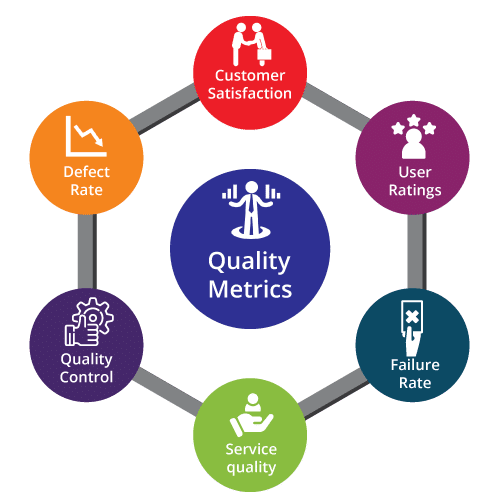Strengthen your Quality Metrics with Quality Engineering
In the light of the recent Cybersecurity scares, there are definite chances that you have been questioning your business application’s sustainability and security in the digital space. Organizations are progressively considering AI tools and Robotics to accelerate their Test Automation efforts and are even evaluating smarter methodologies to make the testing activity cost-effective and time-productive. QA plays a major role in ensuring consumer experience, hence different methodologies and tools are being implemented to make it more efficient. How can Quality Engineering help testers and developers to enhance and toughen various Quality Metrics?
Quality metrics are constituents that enable effective quality management, which help teams to ensure customer experience/user experience. A product or an application is built with defined quality parameters and a scope of work that is expected to deliver acceptable levels of consumer experience. It is important that all these components translate into performance and functionalities that are tangible. Quality Engineering takes a superseding approach towards confirming various quality standards, metrics, and quality parameters.
What is the value that Quality Engineering brings?
Performance, functionality, security, and accessibility are some of the key factors that are expected from an application. These cannot be possibly achieved without following a stringent process and scrupulous monitoring. Technically speaking, Quality Engineering is a quarterly review process that focuses on quality control and quality assurance management by leveraging physical technology, defined standards, and measurable tools.
Quality Engineers implement the best practices that can help to build a robust quality management system within an organization. This requires mastery and skills, as the processes set by Quality Engineering team will define the overall quality assurance and quality control results. It is an asset that has to evolve over time and form an essential element of the organization. These defined processes help teams to emphasize on quality even on a firefighting mode, especially when the focus is primarily on resolving the current issue.
Quality Engineers look at a long-term perspective, mainly to avoid the issue than to fight it out every time it occurs. This can be achieved by conducting thorough data analyses and statistical assessments to derive organizational insights that are dependable. These insights help to align processes that can enable teams to reduce waste of efforts, resources and ultimately also bring down the defects.
Moreover, flexible and responsive methodologies such as Agile and DevOps function differently and have rules that are contrary to the traditional mode of testing. This reinforces the role of Quality Engineering, as despite constant changes and flexible schedules, teams will have to align with the defined quality standards and practices. In this manner, applications and software continue to get the required validation from quality assurance teams.
How important is Quality Engineering for maintaining the Quality Metrics?
An application can be delivered at speed, but how do you decide if it is good enough for your consumers? Adoption of digital technologies is changing the face of Application development, resulting in multiple challenges for testing and development teams. Enhanced user experience has to be achieved, but at the same time quality needs to be ensured.
Quality Engineering efforts are needed to not only test the software quality, but also to analyze and enhance quality throughout the application development lifecycle. It helps teams to align with various Quality metrics to achieve them even in the longer run.
Ensure Quality across the application development lifecycle
Businesses are demanding faster turnaround time and shorter delivery cycles to deal with changing market dynamics. Likewise, teams are focusing on automating the software development process and making it cost effective. Whether it is new technology adoption, implementation of a new tool, or automating the testing efforts, QE helps teams to stay on track and check the relevant quality metrics throughout the development cycle. Ultimately, teams are able to validate the quality of a build and stay in sync with the quality metrics.
In tandem with the User feedback
In this case the user could be the end customer or an organization that needs to develop a business application. It is important that development and testing teams stay in sync with the user sentiments, which can be derived from various ratings, feedback, or any kind of market survey. This is fundamentally how users are accepting your application, where the experience is weighed against the expectations.
There are multiple quality factors that are addressed in the process – usability, accessibility, stability, and security. QE enables teams to meet all these quality metrics by setting up the necessary quality standards and processes for every sprint.
Scope for Constant review and Continuous Improvement
Customer preferences keep changing and organizations need to keep innovating and improving to keep up with the changing demands. Hence, on an ongoing basis, there has to be full scope for continuous improvement and change. While this happens, teams need to focus on quality to deliver the expected experience. QE defines practices that empower teams to control the quality and stay in sync with the continuous improvement metrics. Moreover, testing and development teams are able to streamline the testing efforts and align better with the development objectives with the defined QE processes.
Quality is a relative term, which can be decoded differently for different organizations. Nonetheless, customer experience can be achieved by ensuring performance, security, functionality, and accessibility. This can be realized with rigorous testing and constant monitoring efforts. QE works essentially to streamline processes and support the teams to align effectively with the quality metrics.
Cigniti’s Quality Engineering services cover the Software Testing Life cycle, Test Consulting and Test Advisory services, Test Implementation, and Managed Testing services including Test Environment Management and Test Data Management. Leveraging process frameworks, methodologies, and tools, we help customers across various industries achieve first-time-right solution releases, quality improvements, and deliver a superior customer experience.
Connect with our team of experts and leverage our QE expertise to successfully achieve your Digital Transformation objectives.






Leave a Reply